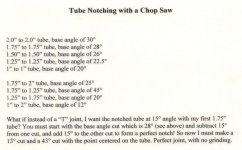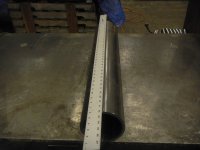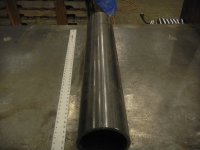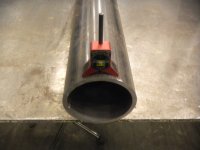You are using an out of date browser. It may not display this or other websites correctly.
You should upgrade or use an alternative browser.
You should upgrade or use an alternative browser.
Pay it forward.
- Thread starter Shield Arc
- Start date
- Views: 10789
/ Pay it forward.
#51
Steveneverlearn
New member
Thank you Shield Arc.
I saw your post on using a mill. I was just wondering if you found a creative way to use a drill and a hole saw.
I wish I had a mill, really wish I knew how to use one too. I'll try a grinder with a cutoff wheel, then move on to a jig.
Thanks again,
Steve
I saw your post on using a mill. I was just wondering if you found a creative way to use a drill and a hole saw.
I wish I had a mill, really wish I knew how to use one too. I'll try a grinder with a cutoff wheel, then move on to a jig.
Thanks again,
Steve
flyerdan
Veteran Member
I've used a hole saw in a drill press to make copes when gate building. We had an air notcher for the small stuff but I'd have to use a 1.875" hole saw on the 2.375" material for cantilever gates. I had a modified drill press vice to hold the pipe and would use the pilot bit for a stop. You had to be careful with the feed rate and speed as it was kind of grabby, but it made beautiful cuts. Added bonus was the overall length was the same every time doing it that way, no variance on grinding irregularities. Just subtract 2" from the os/os length when cutting the top and bottom rails. To keep the copes oriented the same way I'd tack a chunk of 1.875" on the back one and let gravity keep things lined up, or have a helper hold it with a level while I secured it, if it was being particularly difficult.
Is this any good? Or is the idea good but the construction is not?
Tubing Notcher & Pipe Notcher
Bruce
Tubing Notcher & Pipe Notcher
Bruce
muddstopper
Veteran Member
I cant say anything good or bad about the HF tubing notcher, but I have been around a few. My first suggestion is not to go cheap on the purchase. Most of the cheap ones are kind of flimsy and dont last long. I suppose for occassional use they are ok, but certainly not in a production senario. the old joint jigger,Ol' Joint Jigger Tubing Notcher — 2in. O.D. Capacity, Model# RTN100 | Tubing Notchers| Northern Tool + Equipment is a decent notcher for hobby use, but you can see the price doesnt reflect the difference in quality. I have a buddy that builds roll cages and he wore out a few of those jigger joints before getting a a better rig. Not sure of the brand, but it is considerably heavier built than the jigger joint. In fact, I think he may of built it himself.
RedNeckGeek
Super Member
- Joined
- Jan 1, 2011
- Messages
- 8,754
- Location
- Butte County & Orcutt, California
- Tractor
- Kubota M62, Kubota L3240D HST (SOLD!), Kubota RTV900
To keep the copes oriented the same way I'd tack a chunk of 1.875" on the back one and let gravity keep things lined up, or have a helper hold it with a level while I secured it, if it was being particularly difficult.
I have a job coming up where I need to cut 45° miters on each end of a 2' piece of tube, and I'm scratching my head how I'm gonna keep the miters aligned. The ends of the tube will be fit into a corner, so they need to align along a right angle. The tables on the bandsaw and mill aren't much help because they're either too small or oriented wrong to let me use a miter gauge. Your idea of tacking a length of something to the first miter just might work, but I'm open to suggestions... :confused3:
Shield Arc
Super Member
Do you have a center head? Mark center of pipe at each end, take a straight edge, or chalk line and make a mark from one end of the pipe to the other end. Transfer this mark to the opposite side of the pipe. You can even quarter the pipe if you want to.
Attachments
RedNeckGeek
Super Member
- Joined
- Jan 1, 2011
- Messages
- 8,754
- Location
- Butte County & Orcutt, California
- Tractor
- Kubota M62, Kubota L3240D HST (SOLD!), Kubota RTV900
Do you have a center head? Mark center of pipe at each end, take a straight edge, or chalk line and make a mark from one end of the pipe to the other end. Transfer this mark to the opposite side of the pipe. You can even quarter the pipe if you want to.
I do! It'll be relatively small diameter tube (1" I'm guessing) so I could use the square attachment as a foot to keep the scale square to the layout table, then slide the center head down until it settles on the tube. Probably have to elevate the tube on some 1-2-3 blocks and v-blocks, but a setup like that would make it fairly simple to transfer TDC from one end of the tube to the other.
THANKS!!!:thumbsup:
Shield Arc
Super Member
CNC Dan
Veteran Member
I have a job coming up where I need to cut 45° miters on each end of a 2' piece of tube, and I'm scratching my head how I'm gonna keep the miters aligned. The ends of the tube will be fit into a corner, so they need to align along a right angle. The tables on the bandsaw and mill aren't much help because they're either too small or oriented wrong to let me use a miter gauge. Your idea of tacking a length of something to the first miter just might work, but I'm open to suggestions... :confused3:
I have one of those digital levels.
I made a small pearch that can be clamped to the wall of the first cut.
So I make the first cut on one end,
then swap ends, and rotate tube to the proper angle and cut second end.








